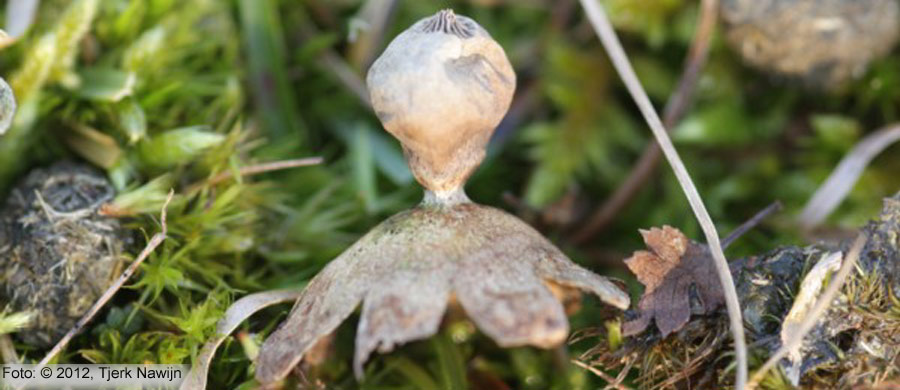
Photo: Dwarf Earthstar, Meijendel, January 12 2012
Notice !
«scale: rabbit dung left
«balloon: normally (flattened) globose, sometimes almost onion-shaped
«apophyse: often Rounded bag-shaped, sometimes (here) Funnel-shaped (risk mistakability Beaked Earthstar)
«stem: short, broad, pale-brown, sometimes almost white
|
Dwarf Earthstar
(Geastrum schmidelii Vittadini)
NMV Ga 211080
Dwarf Earthstar is a lover of humous-poor, calcareous-poor or calcareous-rich dunal sand,
and poor dunas grassland, heathland, lyme-grassland and open dunal bush.
During a mycological study-week in 2001 (organisized by the Dutch Mycologist Union-NMV)
I met my first Dwarf Earthstar.
Since then I've never seen one. Two possible causes: too small, and I'm seldomly visiting dunes in that season. Normally I go there in the plant gall season.
Dwarf Earthstar has a greater distribution area than just the Northsea dunal coast. Dwarf Earthstar also have been found along and in the former Zuiderzee
(Huizen to Spakenburg, Harderwijk, Flevoland), but I have not seen it there, neither
|
Habitat:
Dwarf Earthstar often is growing in fairy-rings, with a diameter upto 20 m. in open landscape at dry soil.
Dwarf Earthstar seems to prefer calcareous dunes at mossy slopes, dunal tops, and dunal valleys,
though this earthstar can be found in calcareous-poor dunes with heathland.
There are hardly any trees to be found at the habitat, but a lot of different shrubs, like
rubis spp., rosa pimpinellifolia, ligustrum vulgare, calluna vulgaris, empetrum nigrum, salix repens, and hippophae rhamnoides,
which means that Dwarf Earthstar can grow nearer to the sea than trees do, even in the outer dunes.
|
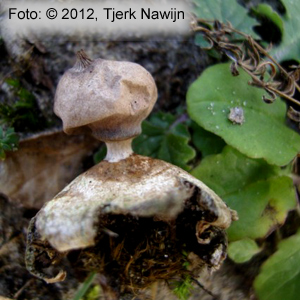
Photo: Dwarf Earthstar,
Meijendel, January 16 2012
«apophyse: rounded bag-shaped |
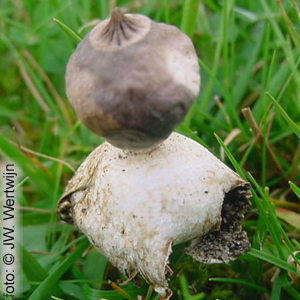
Photo: NMV-werkweek Zeeland,
Vroongronden, October 13 2001
«plicate-furrowy, ring-furrow |
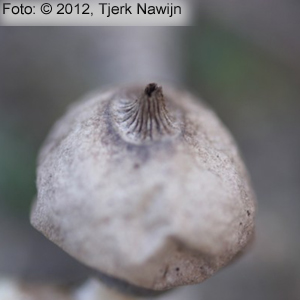
Photo: Dwarf Earthstar,
Meijendel, January 16 2012
«plicate-furrowy, ring-furrow |
Herbarium:
In a herbarium (sample of dried earthstars) mistakability chance is greater with
Field Earthstar (Geastrum campestre)
and Beaked Earthstar (Geastrum pectinatum).
In a dunal area this three species can grow adjacent to each other.
Regional:
Mistakability in the urban Amsterdam area is almost impossible. This three species never occor in the same area.
Darf Earthstar existence in unknown in the Amsterdam area. Only Field Earthstar once (1998) has been found in the garden of the Academic Hospital (AMC).
But that garden was not the right habitat for Dwarf Earthstar and Beaked Earthstar.
|
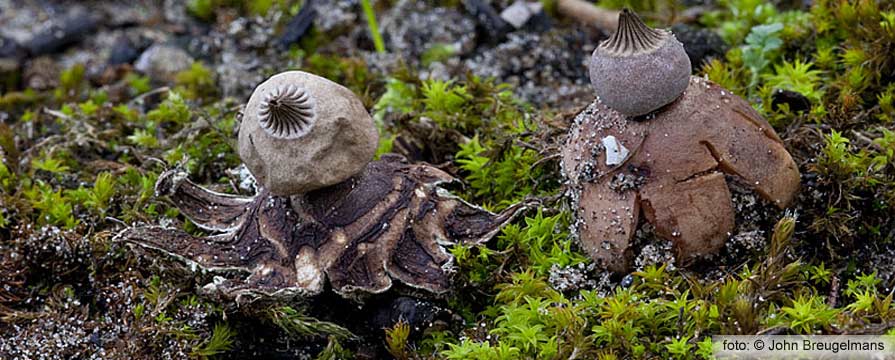
Photo: Dwarf Earthstar;
Notice !
«mouth-zone: plicate-furrowy, sharp limited, ring-furrow
«star-rays: encrusted debris
«star-rays-number: 6-9
«star-rays-thickness: fresh remarkable thick (2,5 mm)
«star-rays-color: crème, sometimes with rosy tint, later coloring brownish
«star-rays-curling-tops: dried rays may have up-curling ray-tops
«habitat: mossy hill-slopes is one of the favorites
|
Mistakability Dwarf Earthstar:
Amsterdam Waterworks Dunal area (AWD) is a place where you can find all three mistakable species together.
The biggest risk is old Beaked Earthstar and old Dwarf Earthstar.
- Beaked Earthstar
Beaked Earthstar is bigger in size, and has a funnel-shaped apophyse (after drying).
Beaked Earthstar has a less clear ring-furrow, a dark-grey balloon, and a longer (> 3mm) stem
- Field Earthstar
Field Earthstar can be as small as Dwarf Earthstar, but the balloon surface is warty and rough
and the star-ray-tops aren hygroscopic
- Tiny Earthstar
Tiny Earthstar also has a short stem (< 1mm long), and a fibrillose mouth-zone (often with ring-furrow).
|
|
Field-marks: See: Anatomy Genus Geastrum
Dwarf Earthstar field-marks:
- Species size: small
- Stem (under balloon): upto 2mm long, pale-brown, normally with apophyse
- Apophyse: most of the type Rounded-bag-shaped, sometimes Funnel-shaped like
Beaked Earthstar.
- Balloon-surface: bald
- Balloon-color: light grey-brown
- Balloon mouth-zone: plicate-furrowy, sharp limited, ring-furrow
- Star-rays-number: 6-9
- Star-rays: non-hygroscopic
- Star-rays: encrusted debris, no scar
|
Literature:
Chrispijn, R. ed. (1999), Champignons in de Jordaan (De paddenstoelen van Amsterdam), Schuyt en Co, 162-163.
Hansen L. & H. Knudsen (1997), Nordic Macromycetes, Vol. 3, Heterobasidioid, aphyllophoroid and gasteromycetoid basidiomycetes, Kopenhagen, 1997, 444 pp.
Jalink, Leo M (1995) De aardsterren van Nederland en België, Coolia 38 Supplement.
www.mycobank.com
|
Top
|